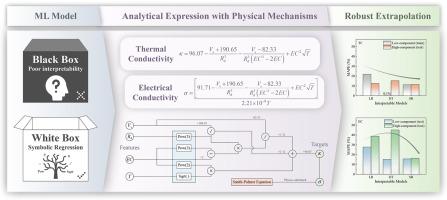铸态镁合金热导率和电导率预测的解析方程:符号回归方法
IF 13.8
1区 材料科学
Q1 METALLURGY & METALLURGICAL ENGINEERING
引用次数: 0
摘要
镁合金的热导率和电导率对成分和微观结构高度敏感,不同铸态合金体系的热导率差异可达20倍,因此快速准确的预测对于高通量筛选和开发高性能合金至关重要。本研究引入了一种物理知识的符号回归方法,解决了传统方法的局限性,包括第一原理计算的高计算成本和机器学习模型的低可解释性。分析了来自60个文献来源的1512个数据点的综合数据集,包括52种合金体系的导热系数测量和36种合金体系的电导率测量。推导出的符号回归模型在低组分和高组分系统中导热系数的平均绝对百分比误差(mape)分别为11.2 %和11.4 %。当与Smith-Palmer方程结合时,电导率预测达到了15.6 %和16.4 %的mape。对来自53个额外文献来源(包括37个以前未见过的合金系统)的554个数据点的完全独立数据集进行独立验证,证实了mape为10.7 %−15.2 %的模型可推广性。Shapley加性解释(SHAP)分析用于评估影响电导率的不同特征的相对重要性,而方程分解则量化了单个功能项的贡献。该方法将数据驱动的预测与机理理解相结合,为基于知识的镁合金定制输运特性设计奠定了基础。本文章由计算机程序翻译,如有差异,请以英文原文为准。

Analytical equations for thermal and electrical conductivity prediction in as-cast magnesium alloys: A symbolic regression approach
The thermal and electrical conductivities of magnesium alloys are highly sensitive to composition and microstructure, with thermal conductivity varying by up to 20-fold across different as-cast alloy systems, making rapid and accurate prediction crucial for high-throughput screening and development of high-performance alloys. This study introduces a physics-informed symbolic regression approach that addresses the limitations of traditional methods, including the high computational cost of first-principles calculations and the poor interpretability of machine learning models. Comprehensive datasets comprising 1512 data points from 60 literature sources were analyzed, including thermal conductivity measurements from 52 alloy systems and electrical conductivity measurements from 36 systems. The derived symbolic regression model achieved Mean Absolute Percentage Errors (MAPEs) of 11.2 % and 11.4 % for thermal conductivity in low and high-component systems, respectively. When integrated with the Smith-Palmer equation, electrical conductivity predictions reached MAPEs of 15.6 % and 16.4 %. Independent validation on an entirely separate dataset of 554 data points from 53 additional literature sources, including 37 previously unseen alloy systems, confirmed model generalizability with MAPEs of 10.7 %−15.2 %. Shapley Additive Explanations (SHAP) analysis was employed to evaluate the relative importance of different features affecting conductivity, while equation decomposition quantified the contribution of individual functional terms. This methodology bridges data-driven prediction with mechanistic understanding, establishing a foundation for knowledge-based design of magnesium alloys with tailored transport properties.
求助全文
通过发布文献求助,成功后即可免费获取论文全文。
去求助
来源期刊

Journal of Magnesium and Alloys
Engineering-Mechanics of Materials
CiteScore
20.20
自引率
14.80%
发文量
52
审稿时长
59 days
期刊介绍:
The Journal of Magnesium and Alloys serves as a global platform for both theoretical and experimental studies in magnesium science and engineering. It welcomes submissions investigating various scientific and engineering factors impacting the metallurgy, processing, microstructure, properties, and applications of magnesium and alloys. The journal covers all aspects of magnesium and alloy research, including raw materials, alloy casting, extrusion and deformation, corrosion and surface treatment, joining and machining, simulation and modeling, microstructure evolution and mechanical properties, new alloy development, magnesium-based composites, bio-materials and energy materials, applications, and recycling.
 求助内容:
求助内容: 应助结果提醒方式:
应助结果提醒方式:


